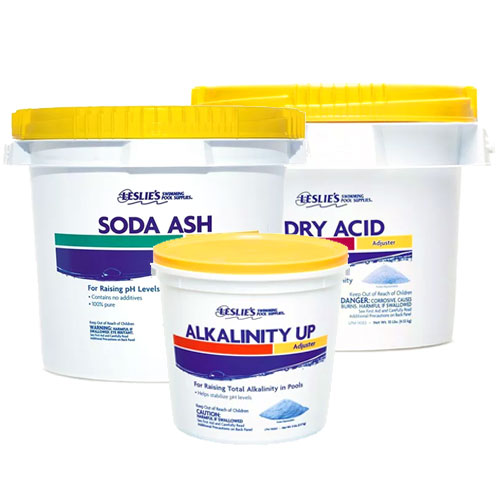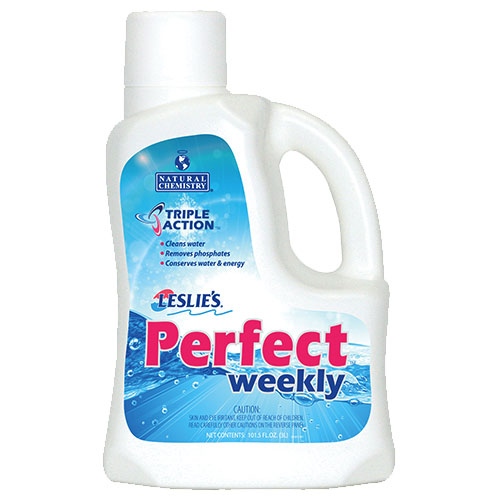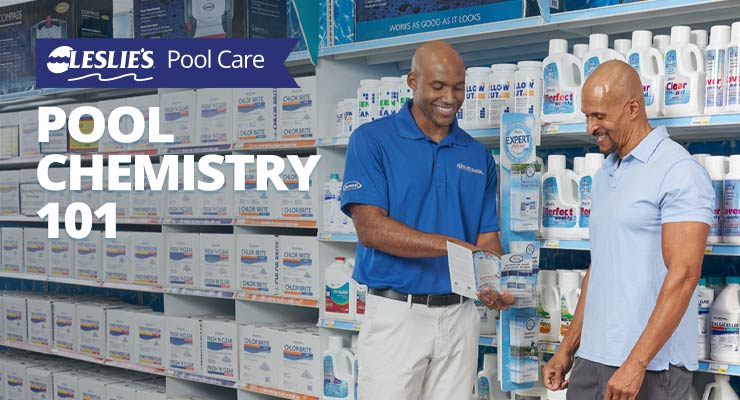
Pool Chemistry 101
You know it’s important to regularly test and balance pool water to maintain a clean, safe, and beautiful pool. But why is it so important? If one aspect of your pool water chemistry is out of range, what does that mean? And how does that affect the rest of your pool?
If you’ve ever performed an at-home AccuBlue Home® pool water test, or if you’ve ever brought a water sample to your local Leslie's store for a free AccuBlue® test, you’ve probably asked yourself these same questions at some point.
In this blog post, we’ll break down the different aspects of pool water chemistry to help you understand the basics. We’ll go over the ideal ranges, how frequently you need to test for them, the role each one plays in overall water balance, what happens when they’re outside the ideal range, and what chemicals you need to adjust them.
Total Alkalinity
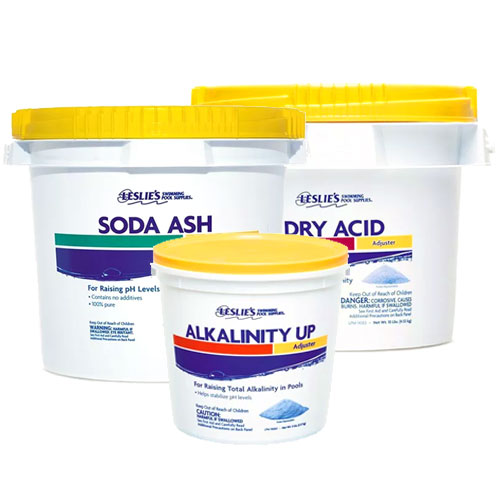
Ideal Range: 80–120 ppm
If you're using calcium hypochlorite (cal-hypo), sodium hypochlorite (liquid chlorine), or lithium hypochlorite as your primary sanitizer, the ideal TA range is 80–100 ppm. When using dichlor, trichlor, or bromine as your primary sanitizer, the ideal range is between 100–120 ppm.
Acceptable Range: 60–180 ppm
Testing Frequency: Weekly
Why it Matters: Total Alkalinity (TA) helps control pH and keep it more stable. When TA is unbalanced, pH pool chemistry will fluctuate more rapidly, or it may be difficult to adjust.
Adjustments: Raise levels with either sodium bicarbonate (Leslie’s Alkalinity Up) or sodium carbonate (Leslie’s Soda Ash), depending on pH levels. If both pH and TA are low, use Soda Ash. You can lower levels with sodium bisulfate (Leslie’s Dry Acid) or muriatic acid. For more information, visit our article on how to balance Total Alkalinity.
pH

Ideal Range: 7.4–7.6
Acceptable Range: 7.2–7.8
Testing Frequency: Weekly
Why it Matters: High pH (alkaline) reduces chlorine efficacy, causes cloudy water, produces stains/scaling on pool surfaces, and can cause skin and eye irritation. Low pH (acidic) also causes skin and eye irritation, causes chlorine to dissipate more quickly, it’s corrosive to pool surfaces and equipment, and can damage vinyl liners, solar covers, and inflatable accessories.
Adjustments: When you need to adjust pH pool chemistry, you can raise levels with sodium carbonate (Leslie’s Soda Ash). Lower levels with sodium bisulfate (Leslie’s Dry Acid) or muriatic acid. For more information, be sure to read our article on how to balance pH levels in a pool.
Calcium Hardness
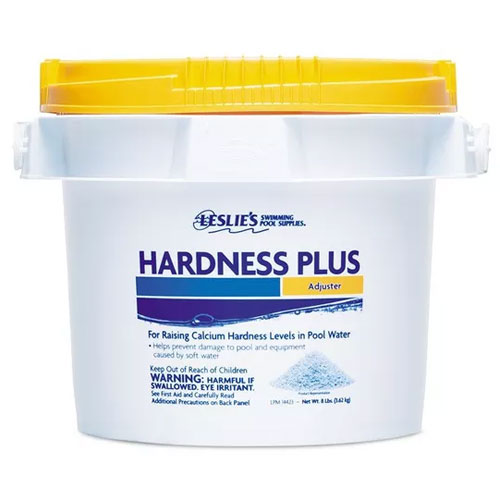
Ideal Range: 200–400 ppm
Acceptable Range: 150–800 ppm
Testing Frequency: Monthly
Why it Matters: Low CH indicates soft water, which causes erosion, etching, and pitting of stone, tile, grout, plaster, pebble, and concrete pool surfaces. Low CH may also cause issues with foamy pool water. High CH indicates hard water, which can lead to scale buildup and cloudy water conditions.
Adjustments: Increase levels by adding calcium chloride (Leslie’s Hardness Plus). Consult with a pool professional about partially draining and refilling the water if levels are higher than the acceptable range. To keep high levels in check, use a scale prevention product to keep the calcium in solution. For more information, check out our article on how to balance Calcium Hardness.
Cyanuric Acid
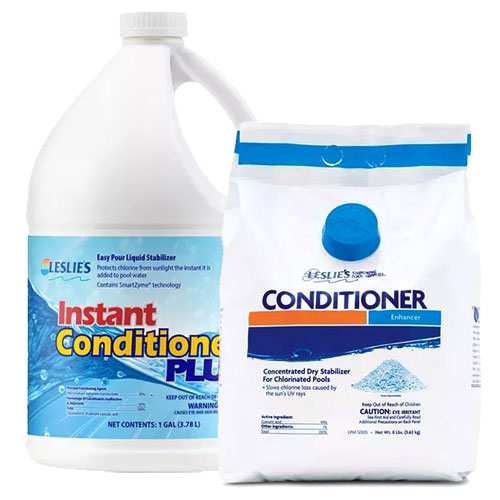
Ideal Range: 30–50 ppm
Acceptable Range: 10–100 ppm
Testing Frequency: Monthly
Why it Matters: Low CYA levels allow chlorine to break down and dissipate quickly in outdoor pools, thanks to the sun's harsh UV rays. High CYA levels cause chlorine to be less effective, and may produce inaccurate chlorine readings in your water test results.
Adjustments: Increase CYA pool chemistry levels by adding Cyanuric Acid (granular Leslie’s Conditioner or liquid Instant Conditioner Plus). Consult with a pool professional about partially draining and refilling the water if levels are excessively high (100–125 ppm or greater). Stabilized chlorine (trichlor tablets or granular dichlor) will add a small amount of CYA with each application. To learn more about keeping up with Cyanuric Acid levels in your pool, check out our helpful resource article.
Chlorine
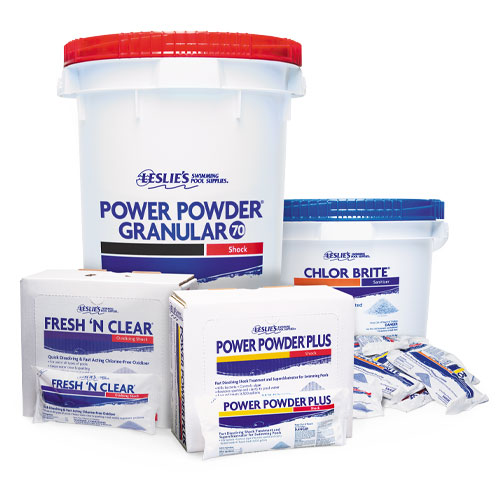
Ideal Range: 2.0–4.0 ppm
Acceptable Range: 1.0–4.0 ppm
Testing Frequency: Weekly
Why it Matters: Chlorine keeps pool water sanitized by controlling organic contaminants in the water, including bacteria, algae, germs, and other microorganisms. Low chlorine levels may expose swimmers to disease-causing organisms in the water, and it can leave your pool vulnerable to an algae bloom.
Adjustments: If your Free Available Chlorine (FAC) is at least 0.3 ppm or more below your Total Available Chlorine (TAC) reading, and/or if chlorine levels are too low, add pool shock. Use a non-chlorine shock (Leslie’s Fresh ‘N Clear) to oxidize the water if FAC levels are at 2.0 ppm or higher. Use a chlorinated shock like cal-hypo (Leslie’s Power Powder Plus 73) or stabilized dichlor (Leslie’s Chlor Brite) if FAC levels fall below 2.0 ppm. Also, make sure your chlorine dispenser is working properly, and that it's providing enough daily chlorine to the pool. Your chemical feeder or chlorine floater should be full of 3" Jumbo Tablets, or if you have a saltwater system, your chlorine generator should be working correctly. If you feel like you're constantly adding chlorine, but your levels are always low, take a look at our article on how to manage chlorine demand.
Metals (Copper, Iron, etc.)
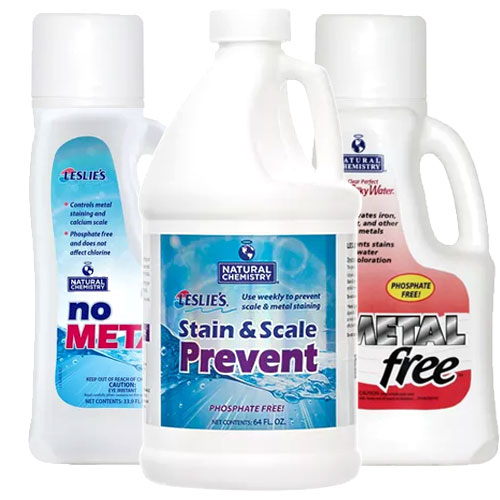
Ideal Range: 0 ppm
Testing Frequency: Monthly
Why it Matters: Metals in the pool can cause staining or discolored water, especially when other aspects of water chemistry are out of balance. Shocking the pool can also initiate the precipitation and oxidation of metals if not properly managed, which leads to pool stains.
Adjustments: Manage metals in the water with a chelating or sequestering agent, such as Leslie's NoMetal, Leslie’s Stain & Scale Prevent, Natural Chemistry METALfree, or CuLator. Need more info? Check out our helpful articles on how to manage metals in the pool or how to identify and treat pool stains.
Phosphates
Ideal Range: 0 ppb
Acceptable Range: 0–100 ppb

Testing Frequency: Monthly
Why it Matters: Phosphates are a primary food source for algae. The higher the level of phosphates in the water, the more likely you are to have algae problems.
Adjustments: Use Leslie’s NoPHOS to remove phosphates higher than 100 ppb. Once you have them under control, use a weekly maintenance product, such as Leslie’s Perfect Weekly triple action phosphate remover, to keep phosphate levels as low as possible. For more help with phosphates, read our article about managing phosphates in pool water.
Total Dissolved Solids
Ideal Range: 0–2500 ppm (for Non-Saltwater Pools), or 0–1500 ppm Above Salt Level (for Saltwater Pools)
Testing Frequency: Monthly
Why it Matters: Total Dissolved Solids (TDS) is a measurement of all dissolved solids in pool water, including minerals, salts, metals, and other suspended inorganic and organic materials. The higher the TDS reading, the harder it is to maintain clean, clear pool water. Pools with high TDS tend to have chronic issues with cloudy water.
Adjustments: There are no chemicals available that will help lower TDS levels. Consult with a pool professional about partially draining and refilling the water if levels are higher than the acceptable range. To learn more, you can find the info in our TDS management tips.
Salt (For Saltwater Pools)
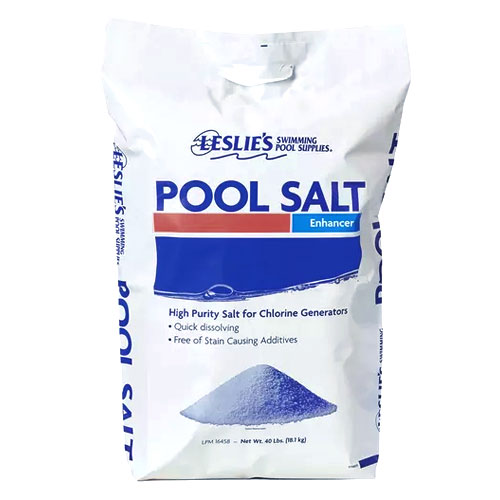
Ideal Range: Manufacturer Recommendations Vary
Testing Frequency: Monthly
Why it Matters: Salt is a crucial part of maintaining a clean and healthy pool if you have a saltwater chlorine generator. Inadequate salt levels will make your salt cell work overtime, causing it to fail sooner. Also, you may struggle with algae, and you’ll spend more money on pool shock and other chemicals to keep the water sanitized, because your salt system may not be able to produce enough chlorine. Salt levels that are too high can cause the same issues you’d find with a high TDS level.
Adjustments: If levels are low, add pure pool-grade salt. Consult with a pool professional about partially draining and refilling the water if levels are higher than the acceptable range. Not sure how much salt to add? Check out our article about balancing salt levels in the pool. If you're getting ready to convert your pool over to a salt system, you can find more information in our saltwater pool conversion guide.
Leslie's is Here to Answer Your Water Chemistry Questions
Now that you have a better idea of what makes up the chemistry of your pool water, it’s time to balance the pool. For a detailed set of step-by-step instructions, head over to our other blog post, How To Balance Pool Water, or click on any of the articles listed in the above sections. If you have more questions about at-home or in-store water testing, our AccuBlue® and Pool Water Testing FAQ post has lots of helpful info to point you in the right direction.
If you still have questions about specific aspects of water chemistry, we can help! Stop by your local Leslie’s store to speak with one of our certified pool experts, or to have us precisely analyze all 10 aspects of your pool water chemistry with a free AccuBlue water test. Once the test is complete, you'll receive a printout with a water quality score. And if any aspects of your pool's chemistry are out of balance, you'll get detailed instructions on how to fix it. The goal is to get your score up to 100%!
